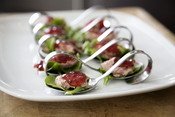And it’s really hard to go wrong making braised vegetables. A quick sauté over high heat will help get a nicely caramelized exterior, and once that’s done, it’s as easy as adding a bit of liquid, and letting the vegetables cook slowly.
Braising is all about the great blend of flavors. The caramelization is awesome, but you also get to add a lot of flavors in the sauce. That makes braised vegetables different from any other type of cooked vegetable.
In this article, I’ll go over everything you know about braising vegetables. First, I’ll go over what braising is. Then, I’ll talk about what ingredients to pick and how to prepare them. Then, I’ll show how to braise the vegetables. Finally, I’ll go over how to make a delicious sauce from the cooking liquid.
Here we go!
What Is Braising?
Braising is a cooking technique where you cook food by partially submerging it in simmering water, in a tightly covered pot. You can also sauté or sear the food beforehand. It’s not necessary, but browning the exterior quickly over high heat can add an extra dimension of flavor to your braised dish.
Braising is especially useful for tough cuts of meat, because the long, slow cooking time helps break down tough fibers so that you end up with a nice tender meal. But it’s also a great cooking technique for vegetables, because of the wonderful flavors you can add, and because it can really help soften tough, starchy veggies.
It might sound very similar to boiling, but there’s a key difference: the amount of liquid used. When you boil vegetables, they’re completely submerged in the water: the water is what cooks them. When you braise, only part of the vegetable is in the water: both the liquid and the steam contribute to cooking the vegetable.
Because you use less liquid, you get less nutrient and flavor loss, so that your veggies taste better. But using less liquid also allows you to use something other than water, without being wasteful. Vegetable or chicken stock can add a lot more flavor to vegetables than water!
And the best part is, once you’re done cooking the vegetables, you have the perfect amount of liquid to make an amazing sauce with. A bit of wine, stock, and citrus can turn ordinary vegetables into amazing ones!
Preparing The Ingredients
When you’re making braised vegetables, there are a few things to prepare. You need to pick and prepare your vegetables and seasonings, and you need to pick a liquid to braise them in.
The Vegetables
There are lots of different vegetables that are great braised. Tough roots, like carrots, parsnips, sweet potatoes, turnips and beets are wonderful, but you can also braise asparagus, green beans, squashes, leeks, cabbage, onions, broccoli, or any other vegetable you like. You can even braise fruit, too. Pineapple, pears and apples can add a sweet touch to your meal.
Once you’ve decided which vegetable to braise, you need to prepare itproperly. That means washing it and trimming it first, and then cutting it up. And how you cut the vegetable is pretty important. Here are a few things to keep in mind.
- The smaller the pieces, the faster they’ll cook. It’s all about how long heat will take to penetrate to the center of the vegetable chunk. So a long, flat piece will cook faster that a largish cube.
- Cut the vegetables into even-sized pieces. If some are much smaller than others, they’ll cook faster and be overdone by the time the rest are ready.
- Try cutting the pieces so that they have at least one flat surface to rest against the bottom of the pot or pan. That way, if you want to brown them first, you have lots of surface area to caramelize.
Once your vegetables are all cut up, you can think about seasoning them.
Seasonings
Braised vegetables are even better with a little bit of seasoning. You can use herbs, spices or aromatics to add a ton of extra flavor and make outstanding dishes.
- Aromatics like onion, garlic, chives, or shallots are great chopped up finely and sautéed when you sear the vegetables. Or for a prettier look, you can use pearl onions and leave them whole.
- Herbs and spices can be used three ways.
- For extra flavor, add them to the hot pan while you’re searing the vegetables – the heat will help release even more of their flavor. You can leave them in after adding the cooking liquid.
- For a milder flavor, just add them to the simmering liquid.
- You can also sprinkle some fresh chopped herbs on the braised vegetables once they’re done cooking.
- You can also use any other seasoning you like. Citrus zest is a good example that goes great with broccoli.
The Cooking Liquid
The cooking broth is one of the things that sets braised vegetables apart from other types of cooked vegetable side dishes.
Because you need so little liquid – just enough to reach about halfway up the vegetables – you can use something a bit more interesting than just water. It’ll add extra nutrition and flavor to your braised vegetables, without being wasteful.
Here are a few liquids you can use when you’re making braised vegetables.
- Water
- Broth or stock – chicken, vegetable and beef are all good
- Wine
- Juice
Those are just a few examples. If you think a liquid will taste great with your vegetables, don’t be afraid to try it! And you can also combine different liquids and make a delicious blend of flavors.
Another neat thing about the cooking liquid is that you can use it to make a tasty sauce to go with your veggies. And that means there’s absolutely no waste. You get to keep the liquid you used, and any nutrients that were leeched out of the vegetables as they cooked. Different cooking liquids will give you a different tasting sauce.
There are so many possibilities, you’ll never get tired of braised vegetables!
Braised Vegetables
Once you’ve picked and prepped your vegetables, seasonings and cooking liquid, you’re ready to make braised vegetables! It’s so easy. Just follow these instructions and you’ll have a tasty vegetable side dish you’ll love!
Here’s how you do it.
- Heat some oil or butter in a pan over medium high heat.
- The pan (or pot) should be big enough to hold all the vegetables in a single layer, if possible. That way, each veggie piece touches the broth without being submerged.
- The pan should have a fitted lid. You don’t want to let any moisture escape when you braise!
- If you’re going to make a sauce from the leftover broth, butter will give a nicer flavor than oil.
- Sear the vegetables in the pan. You can let them brown as much as you like. At this point, you can also add any aromatics or herbs, if you want to intensify flavors.
- If you like, you don’t have to sear the vegetables at all. Searing adds a certain flavor to braised vegetables, but if you don’t like it, just skip it!
- The vegetables will sear more quickly if you don’t move them around too much. This way, the outside will brown without the inside cooking – so that it can cook by braising instead.
- Add the cooking liquid and any other seasonings, and bring to a boil.
- Place the lid on the pan, and reduce the heat. You want the liquid inside to simmer gently.
- Let the vegetables cook until they’re as tender as you like them.
- You can test them by sticking a knife in them to see how soft they are, or just by eating a piece every so often.
- Check the level of the cooking liquid, and add a bit more if it gets too low. You pan should never be dry.
- Vegetables don’t take too long to braise. For dense, hard vegetables like turnips or beets it might take 30 minutes or more, but most vegetables will be done under 15 minutes.
- Serve, and enjoy!
That’s really all there is to braised vegetables. The real magic comes in when you pick different vegetables, seasonings and cooking liquids. And experimentation is the best way to find a meal you’ll love!
Notes
- If you prefer, you can also braise the vegetables in the oven. Once they’re seared, just place them in an oven safe dish, add the cooking liquid, and place them in an oven preheated to 300F. This method is nice if you have a dish that can go on the stove-top and in the oven, to minimize cleanup.
Making A Sauce
Once you’re done braising the vegetables, you’ll notice you have some cooking liquid left over. And although you could throw it out, you’d be throwing out delicious flavors from the broth, and all the nutrients it leeched from the vegetables.
If you like, you can save the broth, and use it in a soup later. But you can also make a delicious sauce to accompany your braised vegetables. It’s really easy to do.
Here how to make a sauce to go with your braised vegetables.
- Taste the cooking liquid. If it’s not tasty, don’t use it. If it’s a little bland, you can add some extra liquid for flavor at this point. Juice or wine make a nice addition to a sauce, but you could also use soy sauce, Worcestershire sauce, or anything you like.
- Add some seasonings, as needed. You might just need a bit of salt, but you can also add herbs like rosemary, or some aromatics like garlic, or even other seasonings like Dijon mustard. Just try out different combinations with different vegetables, and you’ll get a feel for what tastes great.
- Remember that if you boil down the sauce, it’ll get more concentrated in flavor, so go easy on the seasonings!
- Bring the liquid to a boil, and let it boil uncovered until it starts to thicken.
- You can also use flour or cornstarch to thicken the sauce. You don’t need a lot, maybe half a teaspoon. It’s especially helpful when your sauce just refuses to thicken – sometimes it just works out that way.
- Reducing the sauce and thickening by boiling rather than with flour has an advantage: concentration of flavor. As water evaporates from the sauce, the sauce gets more and more flavorful.
- Spoon the sauce over the braised vegetables, or toss the veggies in the sauce to coat them.
- Serve and enjoy!
And that’s how you make braised vegetables, and a delicious sauce to go along with them. It’s so easy, you can do it every night!










